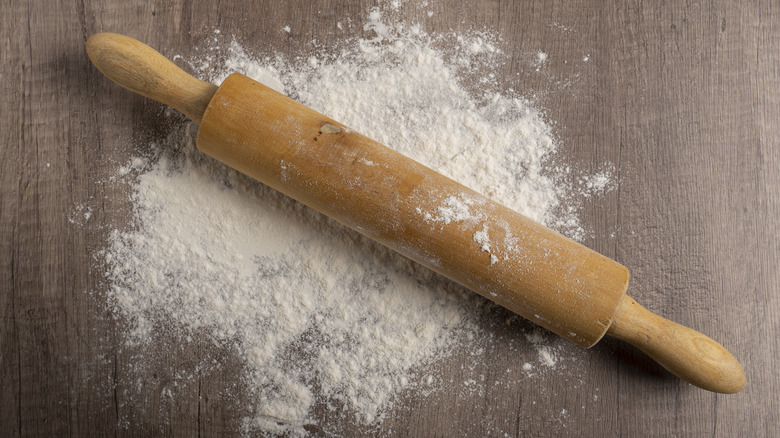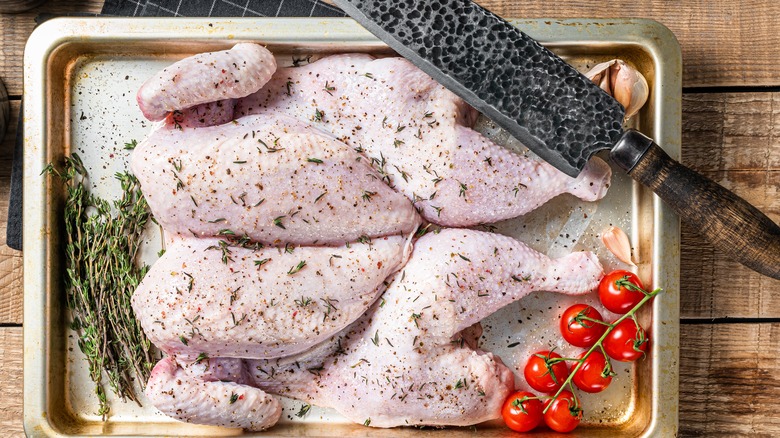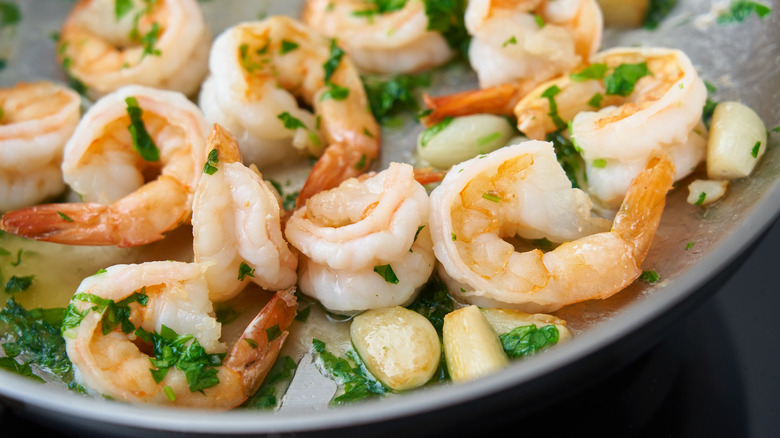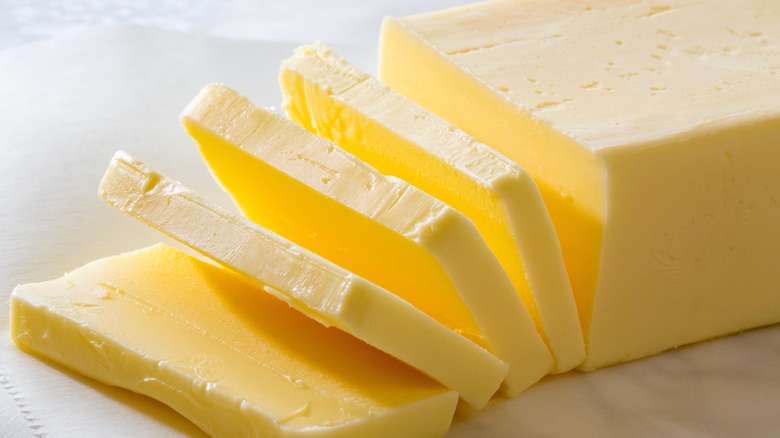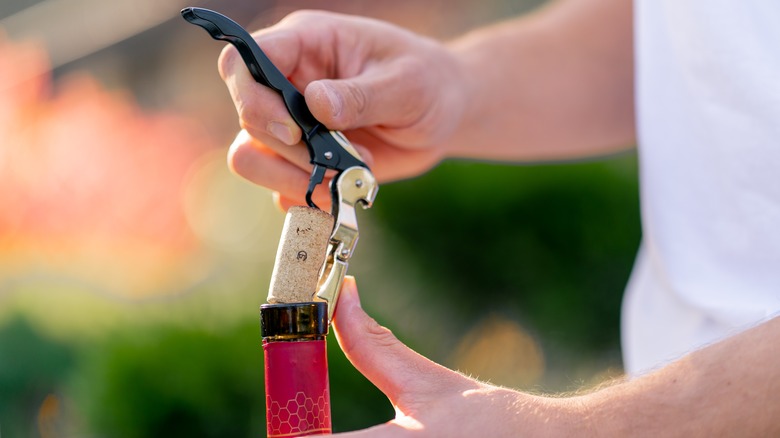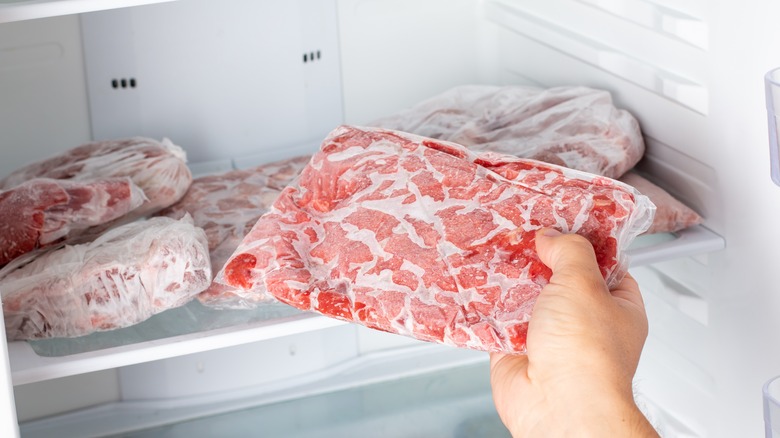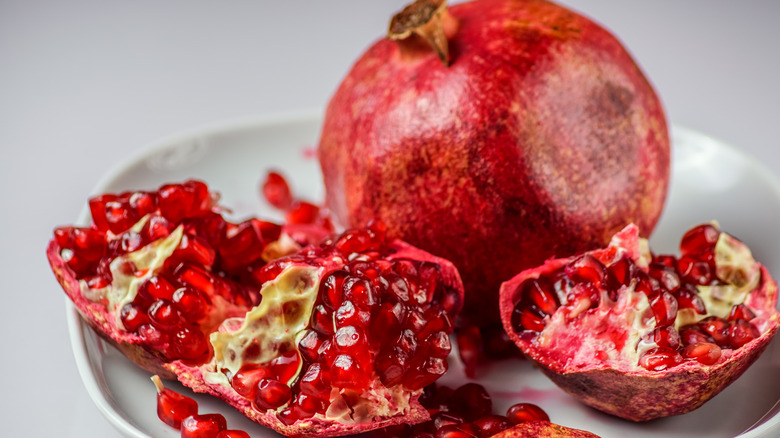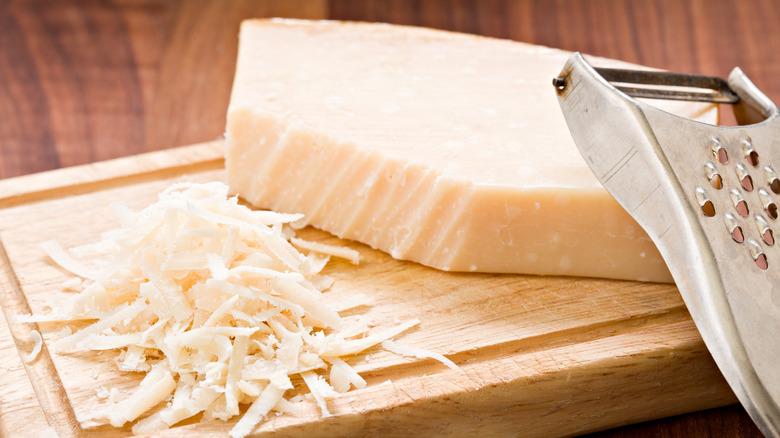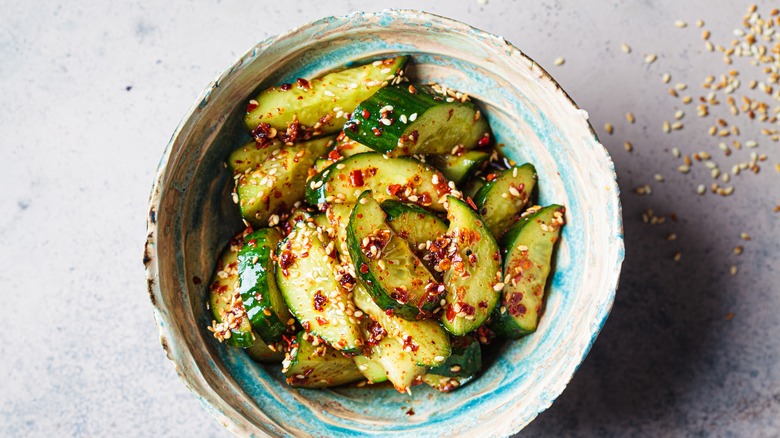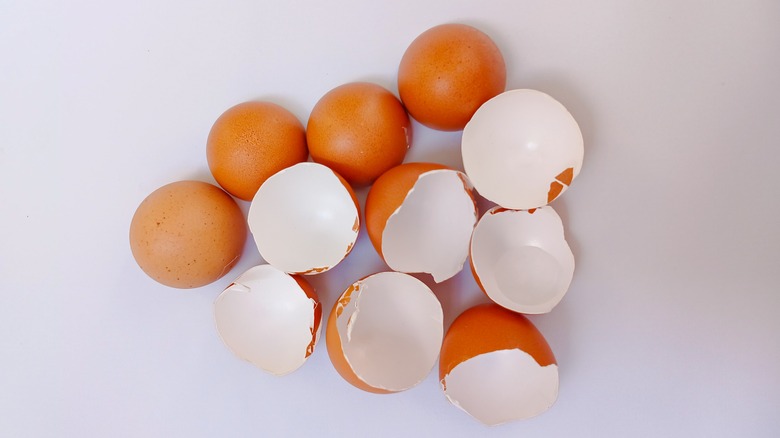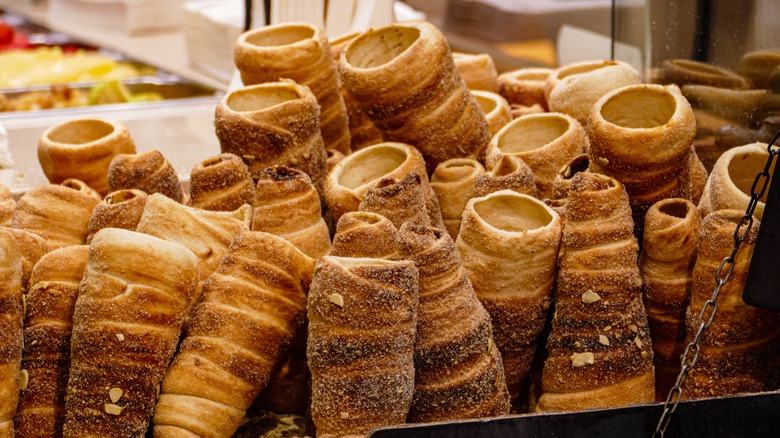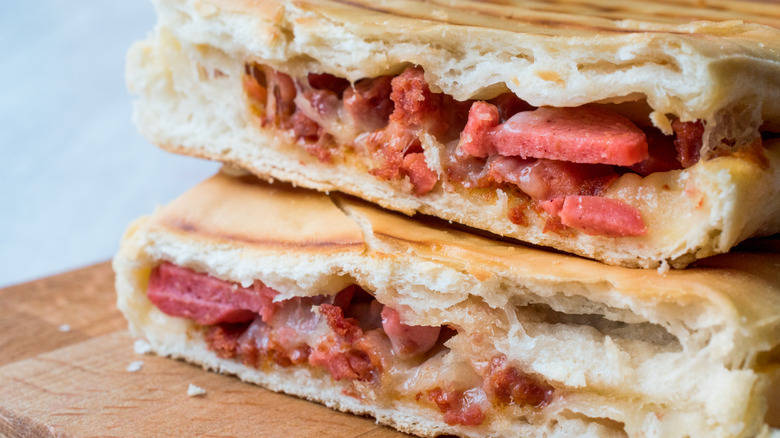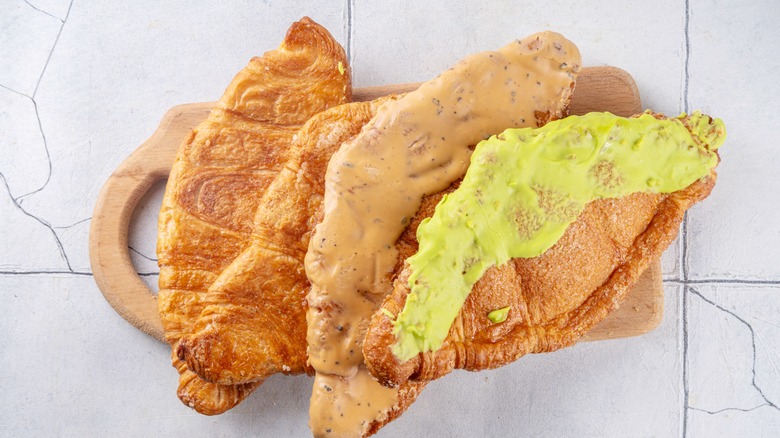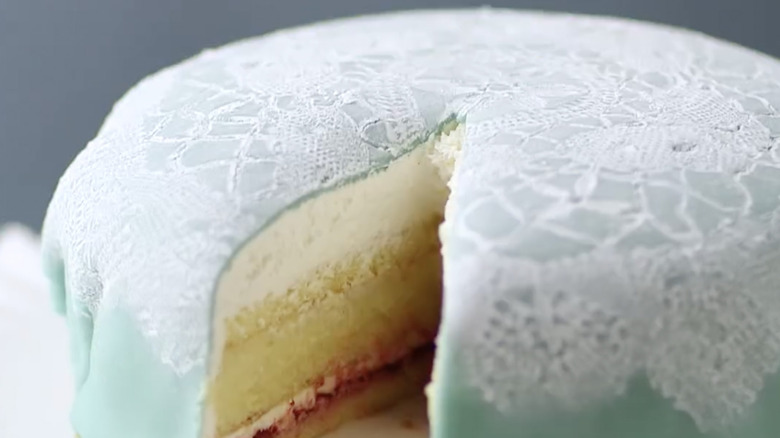15 Creative Ways To Use A Rolling Pin
After many years of using wine bottles to roll out cookie dough and pastry, I finally gave in to the demands of adulting and purchased a rolling pin. I have to admit that it is a major improvement. It is far easier to get a smooth, even layer when you are using the actual tool for the job, and you don't get flakes of wine labels coming off.
While this has been a recent revelation for me, rolling pins have been a standard baking tool for millennia. Objects made for flattening food have been found in early civilizations from Rome to Mesopotamia. A version closer to what we use today was invented by John W. Reed. In 1860, he patented a rolling pin made in two pieces, with a hollow wooden cylinder and handles running through it. Still, even today, some bakers prefer French rolling pins, which are thinner and have tapered ends rather than handles.
Whatever your preference, a rolling pin is a valuable tool in any kitchen, not just for rolling out dough. There are plenty of occasions to use a rolling pin creatively. From juicing pomegranates to grinding eggshells, here are ways to use your rolling pin that you may have never even thought of.
Freeze your rolling pin for better pastry dough
Pastry baking is a mysterious art, and subtle changes in temperature or ingredient choice can make the difference between a melt-in-the-mouth pie case and one that your dinner guests will leave on the side of their plate. Most chefs have hacks for getting it right, and one such tip is to freeze your rolling pin for better pastry dough.
If you put your rolling pin in the freezer for 10 to 15 minutes before you use it, it will prevent the butter from melting as you roll out your dough. This is a small but powerful change because when you make your pastry, you want the butter to melt in the oven. If it melts while your dough is raw, it can lead to a heavy, greasy pastry that is unpleasant in the mouth. Using a chilled rolling pin is especially useful for laminated pastries. Making puff pastry, for example, requires you to roll layers of butter between layers of dough. Using cold tools helps keep these layers defined — so that when the butter melts in the oven, it creates pockets of steam within your pastry and leaves those perfect flaky layers.
Keep your chicken juicy and your beef tender
If your beef tastes chewy or your chicken dries out every time you cook it, this hack is for you. Before cooking your meat, use a rolling pin to flatten it out, which breaks down the connective tissues in your protein, resulting in a more tender piece of meat.
For chicken, start by spatchcocking your bird, which means you remove its backbone with kitchen shears so you can lay it out flat. This method cuts down on the cooking time of your poultry and creates a large surface area of crispy skin. Stuff a pack of butter under the skin, and use a rolling pin to spread it out evenly over the entire chicken. Pressing down on the chicken tenderizes the meat, while the butter will keep the inside moist and help crisp up the skin.
When it comes to beef, especially tougher cuts like flank or skirt steak, a rolling pin can be equally useful. Lay the meat between two pieces of plastic wrap or parchment paper, and use the rolling pin to pound it, then slice it into small pieces against the grain. This simple process will tenderize your beef and can be used for any recipes that require shallow frying beef, from beef stir fry to beef fajitas or beef stroganoff.
Improve your fried shrimp with a quick smash
Now that we have discovered the amazing art of hitting meat with a rolling pin until it tastes better, it isn't all that surprising that the technique also works for a much smaller protein: shrimp. Since shrimp is so tiny, it cooks very fast, so it is important to find ways to keep it buttery rather than dry and rubbery. A quick smash with a rolling pin is the secret to better fried shrimp.
The pressure exerted by the rolling pin breaks down some of the bonds within the protein, making it more tender. It also breaks through the slightly thicker outside layer, letting flavors into the inside of your shrimp. Plus, giving your shrimp a hit with the rolling pin makes it an even thickness, which translates to an even cook. Once your quick smash is complete, you can continue with your recipe, whether that is simply frying your shrimp in butter or bread-crumbing, or battering it first. Make sure you don't cook it too long, as even a bash with a rolling pin won't stop it from drying out.
Prepare your butter for baking
Butter is a key ingredient for baking cakes, cookies, and pastries. Many recipes call for it to be at room temperature, as softened butter is easier to cream with sugar and combine into your mixture. Leaving your butter out of the fridge for around 45 minutes can be enough time for it to soften, but if you are in a hurry or if the room you're baking in isn't the ideal "room temperature" recipe developers had in mind, it may not work. On hot days, your butter can melt very fast, and on cold days, it can remain rock solid and hard to handle. Fortunately, whatever the weather, you can soften your butter for baking using a rolling pin.
All you need to do is place your block of butter between two pieces of parchment paper, then use your rolling pin to flatten it into a foldable sheet about ¼ inch in thickness. Cut it into squares; within minutes, it will be soft and ready to be added to your mixture.
Fit corks back into wine bottles
Sometimes, you just want a glass or two of wine and worry that if you open the whole bottle, it will spoil. Rather than drinking more than you want to or skipping it entirely, you can easily put the cork back in the wine bottle, which will keep the flavors intact for another day. It is usually safe to drink wine for a few days after it has been opened, but chemical processes begin when the wine meets the outside air, which can affect the taste. For instance, oxidation, or the reaction between the wine and oxygen, can mute the flavors and aromas. Certain bacteria can consume the alcohol in your wine, turning a vintage into something closer to vinegar. Putting the cork back in the bottle slows these processes.
Unfortunately, this can be tricky, as corks often expand when you remove them from your bottle. That can be solved with a rolling pin. Place your cork on a flat surface and roll up and down on it, turning the cork to reach the different sides. Once the cork has been flattened back to its original size, you should be able to slide it back in easily. Don't use this method if your cork is fragile and flaky, as it might crush it further and lead to bits of cork in your wine. Once your bottle is sealed, you can keep it in the fridge for a few days.
Try Gordon Ramsey's steak seasoning hack
When you have a beautiful steak, you have to do it justice by seasoning it well and cooking it to perfection. On paper, that might seem straightforward — can there really be more than one way to sprinkle seasoning on a steak? Well, as it turns out, yes, there can. Chefs know the simple techniques to elevate a steak. For instance, Gordon Ramsey, T.V.'s scariest celebrity chef, uses a rolling pin to push the seasonings deeper into the cut of meat.
In an episode of "Next Level Kitchen", he demonstrated his method for making a perfect steak by sprinkling it with seasonings on both sides and then rolling over it with the rolling pin. "By rolling the steak it actually forces the seasoning inside the steak," explains Ramsey. This ensures that the seasoning sticks to the steak, amping up the flavor, flattening the steak slightly, and allowing for a shorter cooking time. He recommends leaving it for at least 20 minutes before cooking it to let the flavors sink in.
Defrost raw meat
Now, for those of us who aren't so good at planning ahead and need a quick way to defrost meat: Your rolling pin is here to help. It can't do the job alone, but it definitely makes other methods quicker.
For example, you can start by using the cold water method, meaning that you let your meat thaw in a bowl of cold water. The United States Department of Agriculture has two important recommendations to make sure this process is safe. Firstly, your meat should be in watertight packaging, or else water and bacteria can get inside. Secondly, you should change the water every 30 minutes to make sure the meat stays at a safe temperature.
Once your meat is 90% defrosted — which should take an hour for small packages and up to three hours for larger ones — it's time for stage two. Take your meat out of its packet, wrap it in parchment paper, and hit it with the rolling pin. You may need to hit it quite hard, so this hack is better used for meat you plan on grinding or chopping it up small.
Juice pomegranates without the mess
Aside from being super tasty, pomegranate is considered a superfood because it has anti-inflammatory properties and high amounts of vitamins, antioxidants, and fiber. Some studies have shown that it helps prevent or treat cancer. You can eat pomegranate seeds by themselves, add them to salads or savory dishes, or enjoy a rich, red pomegranate juice.
It can be messy to make pomegranate juice, but with the help of your handy rolling pin, you can make the job easy. Use this helpful hack to easily remove pomegranate seeds by cutting half way down into the fruit and plunging it into a bowl of water. As you carefully pull it apart in the water, the seeds will sink and separate from the white pith. Recuperate your seeds, place them in a sealed plastic bag, and use a rolling pin to crush them. Once the bag is filled with juice, cut a small hole in it, strain the liquid, and enjoy.
Make crispy cheese taco shells
Tacos are already a treat, but imagine making them even richer and more delicious by using taco shells made entirely of crispy cheese. This is great if you are eating keto or low-carb, or if you just really, really like dairy. It is also incredibly easy: You lay out shredded cheese on a piece of parchment paper, arranged in a circle around the size you want your taco shell. Don't make it too thick — a single layer of cheese is fine. Put it in the microwave until it is fully melted, which should take one to two minutes.
This is where the rolling pin comes in: You are going to use it as a mold. Wrap your circle of cheese around the pin, with the parchment paper still on it so it doesn't stick to the wood. This will give you crispy cheese in the shape of a taco shell.
You can fill this with basically anything because, let's be honest, most things are improved by wrapping them in cheese. Consider this easy ground beef street taco recipe.
Squash cucumbers to make perfect pickles or a smashing salad
We've seen how useful our rolling pin can be for smashing all sorts of meats into tenderness, but you might also want to smash some of your vegetables, and in particular, cucumbers. Crushing them releases the juices, seeds and smells, and makes room for them to seep up sauces or salad dressings. That's why smashing cucumbers before seasoning them is a classic Chinese culinary technique.
I love cucumber salads, especially in the summer, because they are so refreshing. However, I didn't realize quite how flavorful these vegetables are until I switched from cutting them to smashing them. The easiest way to do this is to cut them in half lengthways, creating a large flat surface. Then, hit them with your rolling pin until your cucumber cracks into several pieces. You can use a knife to finish cutting or to make them into more even sizes if need be. Once they are the right size for your salad, cover your pieces of cucumber in salt and let them sit. To turn your cucumbers into a tasty Asian cucumber salad, cover them with a zesty lime dressing and add chili flakes. Alternatively, smash your cucumbers with a rolling pin and place the resulting chunks in a classic dill pickle liquid for deliciously tangy smashed pickles.
Turn eggshells into a dietary supplement
Chefs usually try to avoid getting bits of eggshell in their dishes, but did you know that eggshells are not only safe to eat, they are actually healthy? They are made of calcium carbonate, which is found in human bones, nails, and hair. Calcium is eaten as a dietary supplement to help protect bone health and prevent conditions like osteoporosis. If you eat half an eggshell, you will have reached your recommended daily calcium requirement.
Luckily, you don't have to crunch down on your eggshells to use them as a dietary supplement, but can make it into a fine powder that is nearly tasteless. Place your eggshells in a sandwich bag, after thoroughly disinfecting them by leaving them in boiling water for around 15 minutes. Use your rolling pin to smash them into a fine powder, which you can add to anything liquid, from smoothies to soups. It will add nutrients without affecting the texture or taste.
Make chimney cakes
In Eastern Europe, chimney cakes are a classic street food, alongside waffles and crepes. Their unique shape is usually obtained by wrapping a yeasted dough around a thick rod on a spit and spinning it around above an open fire. If you don't have a chimney-cake rotisserie set up at home, you can DIY one with a rolling pin and make your very own homemade chimney cakes. Wrap aluminum foil around a rolling pin, twist the strips of dough around it, and bake it standing up in a standard oven.
When your chimney cake is ready, remove the rolling pin carefully so your chimney doesn't crack. Dip it in a mixture of sugar, crushed walnuts, cinnamon and cocoa, or fill it with your spread of choice. You can even try savory variants, using your chimney cake as the outside of a sandwich, and filling it with ham, cheese and salad.
Leftover bread can make toaster pizza pockets
Some nights all you need is a pizza pocket that you stick in the toaster and then devour. To recreate the frozen pizza pockets of childhood parties, one TikTok creator has a simple recipe using everyday sandwich bread, a rolling pin, and your favorite toppings. Take two squares of bread and flatten them out with a rolling pin. This will give the bread a texture closer to traditional pizza bases, and allow your homemade pocket to fit in the toaster.
Top your slices of bread with your favorite pizza flavors, making sure to leave them in the center. Place your two slices together, with the toppings inside. Cut off the crusts of your bread and use a fork to crimp around the edges of your pizza pocket. You can also press the edges together by pushing down firmly on your trusty rolling pin. Pop your pizza pocket in the toaster and enjoy an easy, comforting snack within minutes.
Flatten croissants to make an ice cream sandwich or croissant chips
It might feel a bit wrong to take a fresh, perfectly golden croissant and roll it over with a rolling pin, but trust me, it will be worth it. Flat croissants are delicious and surprisingly versatile. You can use them as the bread for your ice cream sandwich. Once you have rolled your croissants flat, give them a crispy and caramelized exterior by frying them in a pan with some sugar or honey. The sweet, crispy, and warm croissant pairs perfectly with ice cream.
I love using slightly stale croissants for this recipe. After a couple of days, croissants usually lose some of their airiness and crispness. When you flatten them out, the airiness disappears anyway, and frying them in a pan brings back that crispy exterior. If you don't have any ice cream, you can try filling them with jelly or chocolate spread, or you can eat them on their own.
Use a rolling pin and a doily to decorate your cakes
If you are making a cake for a special occasion, or have binge-watched too many episodes of the Great British Baking Show, you may want to try your hand at some fancy cake decorating. An easy, but incredibly effective method of doing this was created by Martha Stewart and requires only a lace doily and a rolling pin.
Martha Stewart uses this technique on a Scandinavian princess cake, but it would work on any cake iced with fondant. With your rolling pin, press a lace doily firmly into the icing, and peel it off gently, leaving a pretty imprint. Dust your design with powdered sugar, and then fend off compliments when people see the intricate, lacy design, that looks like it took hours to make. This method is also a great way to cover up any imperfections or cracks in your fondant work.
Static Media owns and operates Tasting Table and Mashed.
